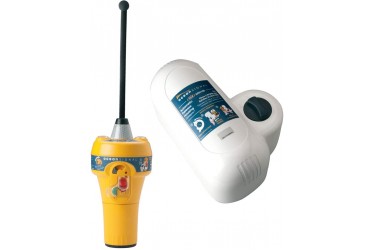The Emergency Position-Indicating Radio Beacon (EPIRB) allows vessels to be located quickly and accurately in times of distress. Singapore-registered ships must register their EPIRB with MPA.
Today's technology takes most of the 'search' out of search and rescue through the utilisation of satellites and modern radio distress beacons. Under the COSPAS-SARSAT international satellite-aided tracking system, polar orbiting satellites are able to detect distress signals from radio beacons.
Mariners call their beacons EPIRBs (Emergency Position Indicating Radio Beacons). An EPIRB is designed to float in water with its antenna pointing upright. and is required to operate for a minimum of 48 hours continuously once activated
The technology of distress beacons is so advanced that the location of the boat, aircraft or individual in distress can be calculated to a search area of around 20km with an analogue 121.5 MHz beacon and further reduced to a search area of as little as 110m with a digital 406 MHz beacon, if encoded with GPS.
The 406MHz beacon comes in two basic types: those that provide an encoded (GPS) location and those that do not. The satellite system can calculate a beacon’s location, but locating a distress site is usually much faster if the beacon signal provides a GPS location. Registration is free.
Note: 121.5 MHz distress beacons will no longer be detected by satellite from 1 February 2009. Older 121.5 MHz radio distress beacons, manufactured before 1990, were designed for detection by overflying aircraft, and not by satellite. These beacons are not compatible with the COSPAS-SARSAT system and should be replaced with a digital 406 MHz beacon.
Float-free EPIRBs are held in a bracket and fitted with a hydrostatic release that is water activated, deploying the beacon automatically if the vessel sinks. If the vessel continues to float, then the EPIRB can be manually deployed where a distress situation exists.
In a distress situation, it is important that once a beacon is switched on, you do not switch it off until rescue has been effected or you are advised to do so by the rescue authority.
Where a beacon has been activated inadvertently, the most important thing to do is:
- Switch off the beacon to ensure that a search and rescue operation is not commenced. There is no penalty for inadvertent activations.
- Notify the Port Operations Control Centre (POCC) in Singapore, which is the operational headquarters for a maritime SRR that covers both the island of Singapore and over 1 million square kilometres of the South China Sea (see Singapore SRR map).
24-hour emergency contact numbers
- VHF Channel 16
- VTIS working channels 7, 10, 14, and 73
- Tel (+65) 6226 5539 or (+65) 6325 2493
- Fax: (+65) 6227 9971
- Telex: 20021
EPIRB registration
Always register your EPIRB.
This will help rescue forces find you more quickly in an emergency. The POCC maintains a database of EPIRBs fitted onboard Singapore-registered ships.
Owners or operators of all Singapore-registered ships must register their EPIRB with MPA by completing and submitting the EPIRB registration form.
If for some reason your beacon gets activated inadvertently, you will receive a call from the Coast Guard. This will avoid unnecessarily engaging SAR resources that may be needed in an actual emergency.
If inadvertent activation is discovered while at sea, the POCC must be informed by the most rapid means of communication, either direct or via another station with passing instructions to urgently forward to the POCC in Singapore.
Testing of EPIRBs should be done at regular intervals and in accordance with the manufacturer’s procedures. Batteries must also be kept in-date and fully charged.
Information about the COSPAS-SARSAT international satellite system can be found at http://www.cospas-sarsat.org.
SATELLITE EPIRB, 406MHZ/121.5MHZ 372511




